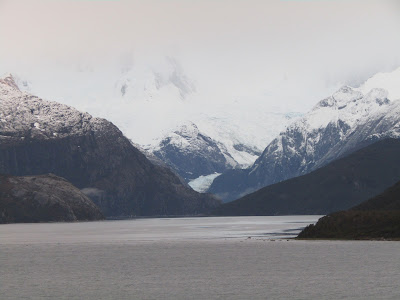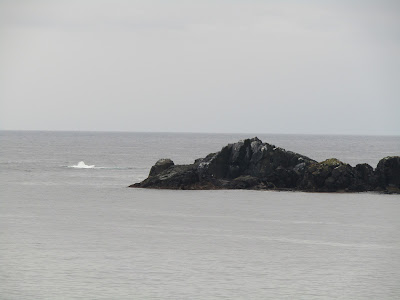Puerto Montt, Chile
Puerto Montt was settled in 1853 but in 1960 was destroyed
by an earthquake. Having been rebuilt it is now a major fishing port and is
known for its salmon production.
Our tour bus took us through downtown and up into the hills
of Puerto Montt where we had a fabulous view of the city. We then drove to the
town of Puerto Varas which is known for its roses. But the centrepiece of the
town is the beautiful Lake Llanquihue, Chile’s largest lake, and the
spectacular snow-covered volcanoes we could see from the foreshore.
We had time to wander through the town on this beautiful
sunny day and stopped at the square to listen to a band playing popular music
on guitar and pan flute. Then we visited a local craft and food market before
walking back along the foreshore and admiring the multi-coloured rose gardens.
From Puerto Varas we drove on to Frutillar, famous for its
music. Along the foreshore are sculptures of a harp and musical notes and an
enormous music hall has been built right on the beach. We wandered through the
lovely gardens of the German Settlers’ Museum and stopped in at a café for
German berry crumble cake and coffee. The German feel of this entire area goes
back to the early days of settlement and the many houses that have been built
in that style.
Lake Llanquihue
One of many volcanoes
They take their volcanoes seriously...
At the German Settlers' Museum
Time for coffee and cake in Fruitillar
Chilean Fjords and Magellan Strait
After weeks of great weather, we found ourselves in fog and
rain for a day as we cruised down the west coast of Chile. But as we approached
the fjords the weather cleared, and the scenery was spectacular.
The fjords are the pathways formed by ancient glaciers and now
filled with water, and as the ship navigated through a plethora of islands, we
couldn’t help but recognise a distinct ‘Cradle’ look about the snow-capped
mountains. Of course the area is volcanic but Australia was also once joined to
South America, so perhaps the comparison isn’t so surprising. However, although
the Chilean fjords are beautiful, they are nowhere near as dramatic as the Sounds
of New Zealand, as many of us here on board agreed.
Punta Arenas, Chile
We arrived in Punta Arenas much earlier than expected, due
to the need for an emergency evacuation, and following a ship-wide request for
volunteers with O Type blood. And so it was under a pitch black sky and a full
moon that we cruised in.
Punta Arenas has a population similar to Launceston with
very few high-rise buildings and a lovely leafy square called Plaza de Armas.
Here, a statue dedicated to Admiral Fernando de Magallanes (Magellan) also contains
an indigenous leader whose big toe you must kiss to ensure your return, but
Penny just touched it…
The city has been the focus of recent protests, as in other
parts of Chile. Most of the bank buildings were boarded up, along with other
public buildings including the beautiful historic museum with its pockmarked
glass doors. Hidden behind wooden barricades was a modern shopping centre and
the national monument Palacio Sara Braun was impressive, along with Punta
Arenas Cathedral, and the sheer number of buildings characterised by French
architecture!
Plaza de Armas
The Indigenous leader's big toe (foot at left)
Museum with pockmarked windows
The entrance to the shopping centre...
...and inside the shopping centre
Some of the beautiful buildings
Cathedral
One of many French style buildings - this one is a bank and it is boarded up
Waiting for the tender back to the ship
Ushuaia (pronounced ooswaya), Argentina
Today started early - very early. Penny’s alarm was set for 4.00am
so we could usher in the sunrise over the Chilean glaciers, and the early rise
was so worth it (see photos)! Then it was back to sleep...
Ushuaia is known as Fin del Mundo or ‘End of the
Earth’ and is the most southern city in the world, its backdrop the magnificent
Andes Mountains. It is the second largest city on the island of Tierra del
Fuego with a population of 70-75,000 - the northern city of Rio Grande has
twice that population. The only habitable place further south (before
Antarctica) is the very small town of Puerto Williams. Ushuaia’s other claims
to fame are that it is the second most important port in Argentina and the
world’s most important port in terms of Antarctic travel, providing passage to
98% of travellers to the South Pole. We drove through the city and on to the
Tierra del Fuego National Park which is only small but is packed full of
beautiful lakes and forests.
These lush forests contain only two main species of tree, both
beeches, and their enemy is the introduced Canadian beaver. As you drive
through there are masses of dams created by the beavers, and thousands of ‘skeleton’
trees that have died as a result of drowning in those dams. The beaver was brought
to Tierra del Fuego to start a fur trade, but the temperatures are much lower
than in Canada and the beavers’ fur didn’t grow enough to support an industry,
so it was abandoned. Now the beavers, who have no predators, are in plague
proportions. Apart from the dams, other areas within the forest not covered in
trees are peat bogs, known as ‘natural sponge’.
We stopped for a delicious lunch of BBQ Patagonian lamb and
salad, a glass of Argentinian Malbec, and the creamiest ice-cream made from the
local blueberry called Calafete. Afterwards we drove back to the city
and visited the old Ushuaia Jail and Military Prison which is now a museum. The
original timber jail was built in 1896 to cater for re-offending prisoners. In
1902 a national prison replaced it, comprising 380 small cells which housed
more than 600 convicts at one time – similar to Port Arthur in style and remoteness.
The building is also home to the Maritime Museum of Ushuaia and the Naval
Models Hall which we of course found interesting.
Cape Horn
Lunch venue
Patagonian BBQ lamb and Malbec
Siberian Husky dog farm
Jail and Maritime Museum
Around the city
Early the next morning we approached Cape Horn which lies at
the southern tip of an archipelago at the junction of the Pacific, Atlantic and
Southern Oceans. It experiences some of the wildest weather on Earth including waves
of up to 10 storeys high! We, fortunately, had smooth seas.
On the point is a lighthouse, family home, small chapel and
utility building. The lighthouse keeper, who has been resident with his family
since 2016, was asked if he gets lonely and his response was, ‘No, there’s a
supply boat every two months so I have plenty of people to talk to.’
Also situated on the point is a memorial to the 10,000 sailors
and mariners who have lost their lives whilst attempting to ‘round the cape’,
and the 800 vessels that have sunk battling the waves. It is a sculpture which
features the silhouette of an albatross and it was created by a Chilean, José Balcells, in 1992. We were soon
around the cape and heading to Puerto Madryn.















































































Hi Penney and Jim...sounds like you're having a wonderful and interesting trip. Wishing you both a great Christmas and all the best for the new year...cheers Dot
ReplyDeleteLooks like you are having a fantastic time. All is good here finally starting to get some summer weather. Merry christmas and we will see you next year.
ReplyDeleteouahh !! super !! the story is so detailed. I'll read it when I wwill have finished Christmas preparation. Kisses to you
ReplyDeleteGreetings, P&J, We had 6 days in Ushuaia in 2008. We note many new features there. The area hosts the most "ginormus" dandelions we have ever seen but at that time there were no real signs of weed control in the city apart for a few token efforts. It looks excellent now. Thankyou. Watch each others back in Bs As the city transport hubs and La Florida are pickpocket hotspot. Be aware that most of Argentinas neighbours will not accept Argentina Pesos (as of 2016) so spend them. Have a good time. Philip, TAS.
ReplyDeletePhilip, I absolutely loved Ushuaia and had the weather been a little better we would have seen much more of the national park. We were made aware in BA of the pickpocket problem but had no issues - great city with beautiful buildings, parks and statues. And we were only left with A$29 worth of Argentina Pesos so that's not too bad.
Delete